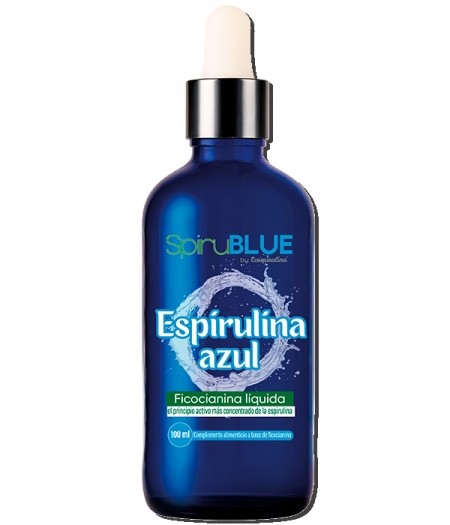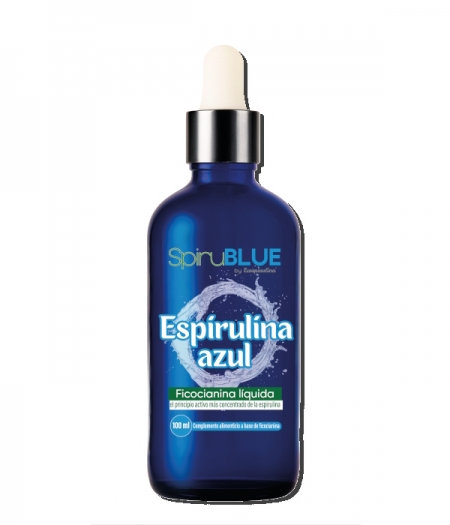Phycocyanin is the natural blue pigment found in spirulina. It is also known as ‘blue spirulina’. It is one of the most powerful antioxidants known in nature.
It helps combat oxidative stress, strengthens the immune system and promotes optimal cellular health.
Unique in the Spanish market, Spirublue is the first organic phycocyanin available in concentrated liquid form.
Cold-extracted using a mechanical process and without solvents so as not to damage its molecular structure, it is the most suitable way to obtain all the benefits of phycocyanin.
The main proven effects of phycocyanin:
- ANTIOXIDANT *1
Antioxidants are molecules that protect the body's cells by neutralising free radicals: unstable compounds that are generated naturally during metabolism or through exposure
to external factors such as pollution, tobacco, stress or solar radiation.
They are vital for cellular and general health. They help prevent disease, delay ageing and keep the body in balance against external and internal aggressions.
Regular consumption, through diet or natural supplements such as phycocyanin, contributes to long-term well-being.
Antioxidants act as cellular shields, and their main function is to:
1. Neutralise free radicals by donating an electron without becoming unstable themselves. *4
2. Prevent cellular damage by protecting key structures in the body. *5
3. Reduce inflammation by limiting cellular stress signals. *6
4. Support the immune system by maintaining the integrity of immune cells. *7
5. Promote liver detoxification, as they participate in enzymatic reactions that eliminate toxins. *8
Phycocyanin, present in spirulina, is an uncommon antioxidant with a unique ability to:
- Trap peroxide and superoxide radicals,
- Protect mitochondria (the cellular energy factories),
- Stimulate internal antioxidant enzymes such as superoxide dismutase (SOD).
- ANTI-INFLAMMATORY *2
Phycocyanin acts by inhibiting pro-inflammatory enzymes such as cyclooxygenase-2 (COX-2) and lipoxygenase, thereby reducing the production of prostaglandins and leukotrienes. It also decreases the release of inflammatory cytokines, which are responsible for chronic inflammatory processes.
The dual action—antioxidant and anti-inflammatory—of phycocyanin protects cells from oxidative damage that fuels chronic inflammation. In animal models, a reduction in pain, oedema, tissue damage and inflammatory markers has been observed after the administration of phycocyanin. Its use may benefit people with chronic inflammatory conditions such as arthritis, autoimmune diseases, or intestinal inflammation.
Unlike synthetic anti-inflammatory drugs, it has no known side effects at moderate doses. Therefore, it is considered a promising natural agent for safely and sustainably modulating inflammation.
- ENERGISING/ REVITALISING *3
Promotes cellular oxygenation and natural energy production (ATP), useful for athletes, people suffering from fatigue, those recovering from illness or convalescing.
It is worth noting a unique property of phycocyanin: its role in erythropoiesis, the process of red blood cell formation, although its action is not as direct as that of erythropoietin (EPO). Some studies suggest that:
1. It stimulates the bone marrow: Phycocyanin can promote the proliferation of haematopoietic stem cells, promoting the production of erythrocytes. *9
2. Cellular antioxidant: It protects red blood cell precursors from oxidative stress, promoting their maturation and survival. C-phycocyanin is up to 20 times more effective than vitamin C! *10
3. Modulation of EPO: It has been observed that it can slightly increase erythropoietin levels indirectly, improving tissue oxygenation. *11
4. Improves iron metabolism: Promotes the absorption and utilisation of iron, an essential mineral for haemoglobin synthesis. *12
5. Supports recovery from anaemia: In animal models, phycocyanin has been shown to accelerate recovery from induced anaemia. *13
In summary, phycocyanin indirectly supports erythropoiesis (red blood cells production), mainly through antioxidant and cell protection mechanisms.
How to consume liquid phycocyanin?
The dark blue glass bottle protects phycocyanin from possible degradation by sunlight. It contains a pipette for dosing.
For regular consumption, 3 to 5 pipettes per day are recommended. It can be taken in a single dose or in several doses. It is recommended to take it in several doses at the beginning, before taking it in a single dose. Dilute the phycocyanin drops in the drink of your choice.
For example, at Ecospirulina we love to dilute phycocyanin with water, aloe vera juice and sea water...
For more intensive consumption (athletes, anaemia or occasional fatigue), 4 to 8 pipettes per day are recommended. For athletes, it is ideal to take phycocyanin during the 2 weeks prior to a competition.
The 100ml bottle is consumed in 3 to 4 weeks. This is an adequate period to notice the benefits of phycocyanin. You can take a break of 1 to 3 months before starting a new bottle (but this is not mandatory, you can take phycocyanin continuously).
Our commitment:
Phycocyanin extracted from our spirulina produced in Spain - Certified organic - Pure, high-quality cultivation water - Harvested early in the day when the active ingredient content is at its highest - Gentle dehydration at a controlled low temperature in our laboratory (maximum 35ºC) to preserve its nutritional richness - Certified by the Valencian Community Natural Parks brand - HACCP quality control system - Respect for the environment - Food packaging made from recyclable materials - Transparency with visits to our facilities - A lot of dedication and love for high-quality production.
Ingredients:
Phycocyanin* (10g/l), water, alcohol* (preservative), agave syrup*.
* Organic ingredients.
Contraindications:
There are no known contraindications for this product. However, consult your doctor if you have any doubts.
Storage:
18 months in a dry place away from light without opening. Once opened, store in the refrigerator at +4ºC and consume within two months of opening.
Origin:
Phycocyanin extracted from our spirulina produced in the Serra Calderona Natural Reserve (Valencia), Spain.
We have taken the utmost care in the production of this liquid phycocyanin. We hope you enjoy it and that it brings you many benefits. We encourage you to discover this blue gold of nature. Spirublue liquid phycocyanin.
Bibliography - scientific sources:
*1 Antioxidant activity
Bhat, V. B., & Madyastha, K. M. (2000). C-phycocyanin: A potent peroxyl radical scavenger in vivo and in vitro. Biochemical and Biophysical Research Communications, 275(1), 20–25. https://doi.org/10.1006/bbrc.2000.3237
Romay, C., Ledón, N., & González, R. (2003). Further studies on anti-inflammatory activity of phycocyanin in some animal models of inflammation. Inflammation Research, 52(7), 230–234. https://doi.org/10.1007/s00011-003-1186-x
*2 Antiinflamatory activity
Remirez, D., Ledón, N., González, R., González, A., & Romay, C. (2002). Role of histamine in the inhibitory effects of phycocyanin in experimental models of allergic inflammatory response. Pharmacological Research, 45(1), 75–79. https://doi.org/10.1006/phrs.2001.0841
Romay, C., Armesto, J., Remirez, D., González, R., Ledon, N., & Garcia, I. (1998). Antioxidant and anti-inflammatory properties of C-phycocyanin from blue-green algae. Current Protein & Peptide Science, 1(2), 207–216. https://doi.org/10.2174/1389203983382431
*3 Energizing / Revitalizing activity
Karkos, P. D., Leong, S. C., Karkos, C. D., Sivaji, N., & Assimakopoulos, D. A. (2011). Spirulina in clinical practice: Evidence-based human applications. Evidence-Based Complementary and Alternative Medicine, 2011, Article ID 531053. https://doi.org/10.1093/ecam/nen058
Jensen, G. S., Ginsberg, D. I., Huerta, P., Citton, M., & Drapeau, C. (2008). Blue-green algae (Aphanizomenon flos-aquae) supplementation in mice reduces pro-inflammatory cytokine levels and improves endurance. Journal of Medicinal Food, 11(1), 123–130. https://doi.org/10.1089/jmf.2007.583
*4. Lobo, V., Patil, A., Phatak, A., & Chandra, N. (2010). Free radicals, antioxidants and functional foods: Impact on human health. Pharmacognosy Reviews, 4(8), 118–126. https://doi.org/10.4103/0973-7847.70902
*5. Pham-Huy, L. A., He, H., & Pham-Huy, C. (2008). Free radicals, antioxidants in disease and health. International Journal of Biomedical Science, 4(2), 89–96. https://www.ncbi.nlm.nih.gov/pmc/articles/PMC3614697/
*6. Biswas, S. K. (2016). Does the interdependence between oxidative stress and inflammation explain the antioxidant paradox? Oxidative Medicine and Cellular Longevity, 2016, 5698931. https://doi.org/10.1155/2016/5698931
*7. Wintergerst, E. S., Maggini, S., & Hornig, D. H. (2006). Immune-enhancing role of vitamin C and zinc and effect on clinical conditions. Annals of Nutrition & Metabolism, 50(2), 85–94. https://doi.org/10.1159/000090495
*8. Lu, S. C. (2009). Regulation of glutathione synthesis. Molecular Aspects of Medicine, 30(1–2), 42–59. https://doi.org/10.1016/j.mam.2008.05.005
*9. Bachstetter AD, Jernberg J, Schlunk A, Vila JL, Hudson C, Cole MJ, Shytle RD, Tan J, Sanberg PR, Sanberg CD, Borlongan C, Kaneko Y, Tajiri N, Gemma C, Bickford PC. Spirulina promotes stem cell genesis and protects against LPS induced declines in neural stem cell proliferation. PLoS One. 2010 May 5;5(5):e10496. doi: 10.1371/journal.pone.0010496. PMID: 20463965; PMCID: PMC2864748.
*10. Pleonsil P, Soogarun S, Suwanwong Y. Anti-oxidant activity of holo- and apo-c-phycocyanin and their protective effects on human erythrocytes. Int J Biol Macromol. 2013 Sep;60:393-8. doi: 10.1016/j.ijbiomac.2013.06.016. Epub 2013 Jun 24. PMID: 23806319.
*11. Chengwu ZHANG. Effect of C-phycocyanin from Spirulina platensis on erythropoiesis in mice. Chinese Journal of Marine Drugs ; (6)1994.
Article in Zh | WPRIM | ID: wpr-537889
*12. Isani G, Niccolai A, Andreani G, Dalmonte T, Bellei E, Bertocchi M, Tredici MR, Rodolfi L. Iron Speciation and Iron Binding Proteins in Arthrospira platensis Grown in Media Containing Different Iron Concentrations. Int J Mol Sci. 2022 Jun 3;23(11):6283. doi: 10.3390/ijms23116283. PMID: 35682960; PMCID: PMC9181241.
*13. Gao F , Guo W , Zeng M , Feng Y , Feng G . Effect of microalgae as iron supplements on iron-deficiency anemia in rats. Food Funct. 2019 Feb 20;10(2):723-732. doi: 10.1039/c8fo01834k. PMID: 30664135.








